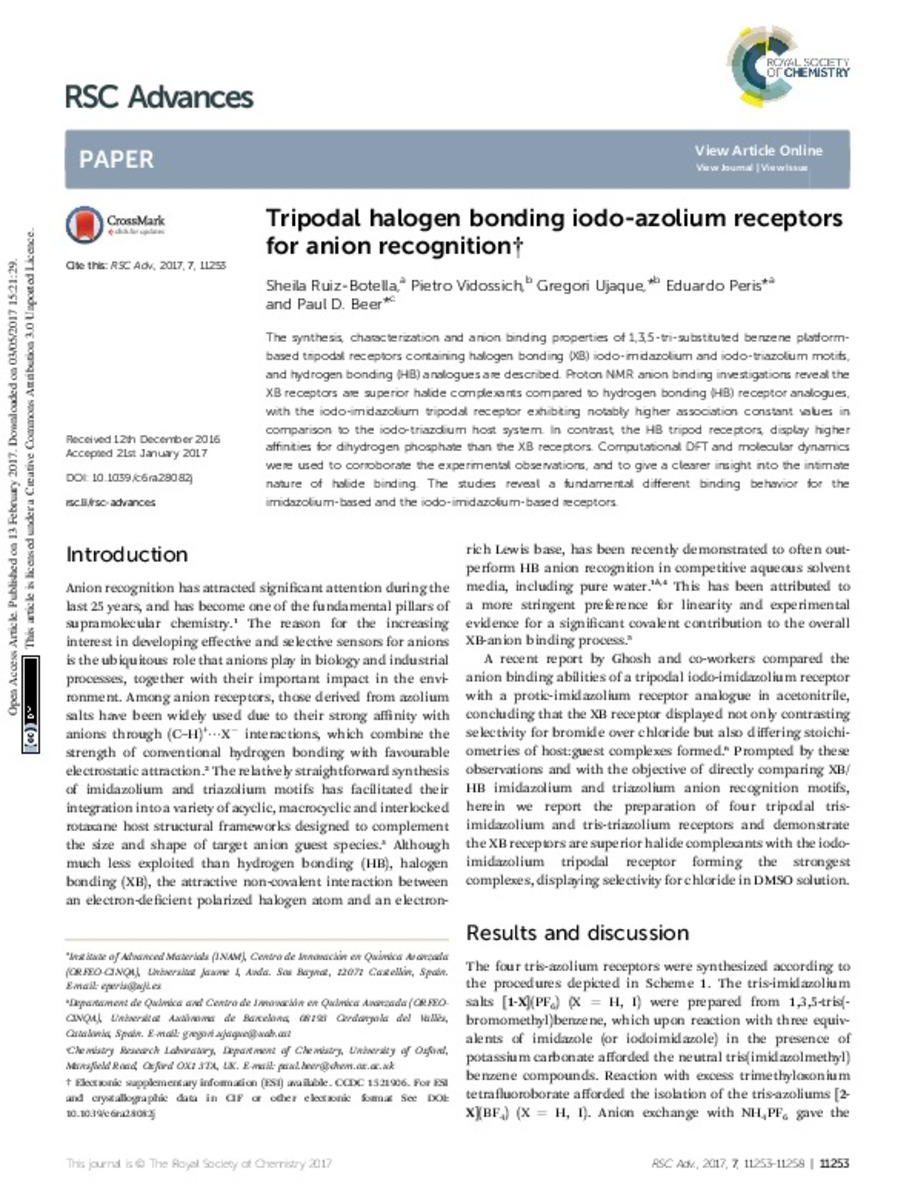Mostrar el registro sencillo del ítem
Tripodal halogen bonding iodo-azolium receptors for anion recognition
| dc.contributor.author | Ruiz-Botella, Sheila | |
| dc.contributor.author | Vidossich, Pietro | |
| dc.contributor.author | Ujaque, Gregori | |
| dc.contributor.author | Peris, Eduardo | |
| dc.contributor.author | Beer, Paul D. | |
| dc.date.accessioned | 2017-05-09T19:04:10Z | |
| dc.date.available | 2017-05-09T19:04:10Z | |
| dc.date.issued | 2017 | |
| dc.identifier.citation | RUIZ-BOTELLA, Sheila, et al. Tripodal halogen bonding iodo-azolium receptors for anion recognition. RSC Advances, 2017, vol. 7, no 19, p. 11253-11258 | ca_CA |
| dc.identifier.issn | 2046-2069 | |
| dc.identifier.uri | http://hdl.handle.net/10234/167512 | |
| dc.description.abstract | The synthesis, characterization and anion binding properties of 1,3,5-tri-substituted benzene platform-based tripodal receptors containing halogen bonding (XB) iodo-imidazolium and iodo-triazolium motifs, and hydrogen bonding (HB) analogues are described. Proton NMR anion binding investigations reveal the XB receptors are superior halide complexants compared to hydrogen bonding (HB) receptor analogues, with the iodo-imidazolium tripodal receptor exhibiting notably higher association constant values in comparison to the iodo-triazolium host system. In contrast, the HB tripod receptors, display higher affinities for dihydrogen phosphate than the XB receptors. Computational DFT and molecular dynamics were used to corroborate the experimental observations, and to give a clearer insight into the intimate nature of halide binding. The studies reveal a fundamental different binding behavior for the imidazolium-based and the iodo-imidazolium-based receptors. | ca_CA |
| dc.description.sponsorShip | We gratefully acknowledge nancial support from MEC of Spain (CTQ2014-51999-P and CTQ2014-54071-P) and the Universitat Jaume I (P11B2014-02). We are grateful to the Serveis Centrals d'Instrumentaci´o Cient´ıca (SCIC) of the Universitat Jaume I for providing with spectroscopic facilities. We would also like to thank the Generalitat Valenciana for a fellowship (S-R.-B.). | ca_CA |
| dc.format.extent | 6 p. | ca_CA |
| dc.format.mimetype | application/pdf | ca_CA |
| dc.language.iso | eng | ca_CA |
| dc.publisher | Royal Society of Chemistry | ca_CA |
| dc.relation.isPartOf | RSC Advances, 2017, vol. 7, núm.19 | ca_CA |
| dc.rights | This journal is © The Royal Society of Chemistry 2017 This article is licensed under a Creative Commons Attribution 4.0 Unported Licence. | ca_CA |
| dc.rights | Atribución 4.0 España | * |
| dc.rights.uri | http://creativecommons.org/licenses/by-sa/4.0/ | * |
| dc.subject | Halogen bonding | ca_CA |
| dc.subject | Binding energy | ca_CA |
| dc.subject | Computational chemistry | ca_CA |
| dc.subject | Hydrogen bonds | ca_CA |
| dc.subject | Ions | ca_CA |
| dc.subject | Molecular dynamics | ca_CA |
| dc.title | Tripodal halogen bonding iodo-azolium receptors for anion recognition | ca_CA |
| dc.type | info:eu-repo/semantics/article | ca_CA |
| dc.identifier.doi | http://dx.doi.org/10.1039/C6RA28082J | |
| dc.rights.accessRights | info:eu-repo/semantics/openAccess | ca_CA |
| dc.relation.publisherVersion | http://pubs.rsc.org/En/content/articlelanding/2017/ra/c6ra28082j#!divAbstract | ca_CA |
| dc.type.version | info:eu-repo/semantics/publishedVersion |
Ficheros en el ítem
Este ítem aparece en la(s) siguiente(s) colección(ones)
-
INAM_Articles [531]
-
QUIO_Articles [705]
Articles de publicacions periòdiques








